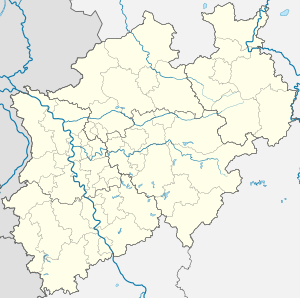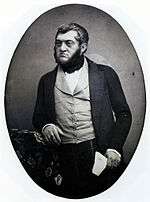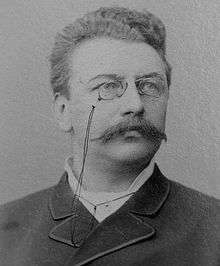Bad Oeynhausen
Bad Oeynhausen (German pronunciation: [baːt ˈʔøːnhaʊzn̩]) is a spa town on the southern edge of the Wiehengebirge in the district of Minden-Lübbecke in the East-Westphalia-Lippe region of North Rhine-Westphalia, Germany. The closest larger towns are Bielefeld (39 kilometres southwest) and Hanover (80 km east).
Bad Oeynhausen | |
|---|---|
 Coat of arms | |
Location of Bad Oeynhausen within Minden-Lübbecke district   | |
 Bad Oeynhausen  Bad Oeynhausen | |
| Coordinates: 52°12′N 08°48′E | |
| Country | Germany |
| State | North Rhine-Westphalia |
| Admin. region | Detmold |
| District | Minden-Lübbecke |
| Government | |
| • Mayor | Achim Wilmsmeier (SPD) |
| Area | |
| • Total | 64.8 km2 (25.0 sq mi) |
| Highest elevation | 269 m (883 ft) |
| Lowest elevation | 45 m (148 ft) |
| Population (2018-12-31)[1] | |
| • Total | 48,702 |
| • Density | 750/km2 (1,900/sq mi) |
| Time zone | CET/CEST (UTC+1/+2) |
| Postal codes | 32545, 32547, 32549 |
| Dialling codes | 05731, 05734 |
| Vehicle registration | MI |
| Website | www.badoeynhausen.de |
History
In the village of Bergkirchen, which belongs to Bad Oeynhausen, a wellspring sanctuary existed in pre-Christian (Saxon) times at the local crossing of the Wiehengebirge, which was replaced in the 9th century by a church. Today's church is a subsequent building. On the church and the downhill-situated Widukind spring plates explain this further. A few metres from the church a 13th-century timbered homestead can still be found.
In 753 Pepin the Short, according to the Royal Frankish Annals, stopped over ad locum qui dicitur Rimiae, so that Rehme is commonly accepted as the oldest part of town.
The origin myth of Bad Oeynhausen relates that in 1745 a local farmer named Sültemeyer noticed that after his pigs had wallowed in nearby mud they had a salty crust on their backs and he decided to investigate the source. After public awareness of this finding, King Frederick II of Prussia ordered the construction of a saltworks, which was named "Royal Saline Neusalzwerk". Today's Sültemeyer Fountain (colloquial: Pig-Fountain), in the city centre, is a reminder of the city's beginning.


After 1830, mining captain Carl Baron of Oeynhausen (1795–1865) oversaw drilling in today's spa garden area in search of salt deposits, but instead found a thermal salt spring in 1845. Quickly the healing abilities of this spring were discovered and first baths were built in the community, which now was called "Neusalzwerk near Rehme". In 1848 King Frederick William IV of Prussia renamed it to "Royal Bath (German: Bad) Oeynhausen", and this name was retained after receiving its own town charter in 1860. The opening of the Cologne-Minden railway line in 1849 connected the city with railroad network.
The growth of spa activities and the town's development continued into World War II. Among other things the Kurpark (spa garden), according to plans by Peter Joseph Lenné, and the Kurhaus (spa hotel) in 1908 (from 1980-2002 a Casino was located here; today called the Kaiserpalais, it hosts a Varieté, a noble restaurant and a discothèque) were constructed. At the beginning of the 20th century residential houses for the bourgeoisie were built around the spa garden. The extraordinary conglomeration of different architectural styles of the spa garden's buildings and the surrounding mansions bestowed Bad Oeynhausen the unofficial title "Museum for the Architecture of the 19th Century". One of the most famous buildings, the "Farne-Villa" was replaced by a new building in 1969.
In the first half of the 20th century additional thermal salt springs were drilled. Among these the Jordansprudel, drilled in 1926, is best known and with a capacity of 6000 l/min and a total height of up to 40 m it is the world's highest carbonated thermal salt spring and de facto the town's landmark.
Under Nazi Germany, Bad Oeynhausen hosted a synod of the Confessing Church, as well as the home congregation to Jakob Emil Karl Koch, a leading member. The World War II tank factory of the town was bombed on 30 March 1945.[2] Post-war, the town hosted the Control Commission for Germany – British Element (CCG/BE), the military government for the British Zone of Occupation and served as the British Army of the Rhine headquarters.
The town was returned to local control in 1954 and spa activities resumed. In 1973, the seven surrounding municipalities Wulferdingsen, Volmerdingsen, Werste, Eidinghaisen, Dehme, Rehme and Lohe of the former "Amt Rehme" were merged with Bad Oeynhausen into one commune. The "State-owned Spa Bad Oeynhausen" (German: Staatsbad), property of the state of North Rhine-Westphalia, was municipalised in 2004.
Geography
Bad Oeynhausen is located on the west bank of the Weser river. It has the world's most highly carbonated thermal saltwater fountain, the Jordansprudel. On calm days the fountain gets up to 40 metres high. The water of the spring is believed to have many medicinal qualities, giving rise to a number of health spas.
Land use
A large percentage of the area is used for agriculture:
| Area |
Settlement and circulation area |
Farmland |
Forest |
Other free area |
|---|---|---|---|---|
| Area in hectares | 2,479 | 3,348 | 518 | 135 |
| Complete percentage | 38.3% | 51.7% | 8.0% | 2.0% |
This applies to the entire district of Minden-Lübbecke, where the majority of the land is used for agriculture.
| Area usage of Minden-Lübbecke [3] |
All told | Farmland |
Forests |
Settlement and circulation area |
Water area |
Other land usage |
|---|---|---|---|---|---|---|
| Area in km² | 1152.22 | 756.7 | 128.98 | 220.13 | 34.08 | 12.33 |
| Complete percentage | 100% | 65.7% | 11.2% | 19.1% | 3% | 1% |
Districts
Bad Oeynhausen consists of 8 districts:
|
|
Climate
The climate in Bad Oeynhausen is controlled by the Oceanic Climate. The values are based on the ones from Herford (Temperature)[4] and the ones in Bad Oeynhausen (Precipitation)[5]
| Month | Jan | Feb | Mar | Apr | May | Jun | Jul | Aug | Sep | Okt | Nov | Dez | Year | |
| Temperature in °C | 1.3 | 1.9 | 4.7 | 8.4 | 13.0 | 15.9 | 17.4 | 17.1 | 14.0 | 10.2 | 5.4 | 2.5 | 9.4 | |
| Precipitation in mm | 61.3 | 45.7 | 57.7 | 52.2 | 62.4 | 73.9 | 66.1 | 65.5 | 60.9 | 46.7 | 61.5 | 71.1 | 724.8 |
Notable buildings
Bad Oeynhausen built a mall called the "Werre-Park". It gets its name from the nearby river Werre and was opened on 1 April 1998.

Demographics
|
|
|
¹ census result
Health treatment facilities
There are a number of health treatment facilities in Bad Oeynhausen. The Maternus Rehabilitation Clinic deals with rehabilitation for orthopedic, degenerative, and neurological conditions. The Klinik am Korso deals with eating disorders. The Median Rehabilitation Clinic specializes on rehabilitation for Muslim patients. The Heart and Diabetes Center North Rhine-Westphalia, an institution of the Ruhr University Hospitals, is a world-leading institution for the treatment of cardiac, circulatory and metabolic diseases. Just outside the city lies the Klinik Bad Oexen, a rehabilitation center for cancer patients.
International relations
Sons and daughters of the town
- 1852–1906: August von Borries, railway engineer
- 1871–1930: Wilhelm Schlüter, politician (SPD)
- 1880–1951: Fritz Tarnow, trade unionist and politician (SPD)
- 1886–1968: Friedrich Altemeier, fighter pilot in WWI
- 1902–1981: Walther Ludwig, opera singer (tenor)
- 1913–2006: F. Wolfgang Schnell, agronomist
- 1935: Siegfried Linkwitz, engineer
- 1966: Christian Berg, author and composer
- 1973: Torben Giehler, painter
- 1979: Arne Friedrich, former footballer of German national team and VfL Wolfsburg
Associated with the town

- Karl Koch, (1876–1951), Superintendent, President of the Evangelical Church of Westphalia
- Adolf von Thadden, (1921–1996), far-right politician, died in Bad Oeynhausen[7]
- Kurt Thomas, (1904–1973), composer and choirmaster
- Peter Joseph Lenné, landscape architect, designed the park
- Frank Gehry, (born 1929), architect, designed two buildings for Bad Oeynhausen

- Reinhart Koselleck, (1923–2006), historian
- Roland Pröll, (born 1949), pianist, conductor, composer
- Georg von Vincke, (1811–1875), Prussian politician, officer, landowner
- René Müller, (born 1959), footballer
- Friedrich Christoph Pelizaeus, (1851–1942), neurologist
- Ingo Petzke, (born 1947), filmmaker and author
- Jochen Fahrenberg, (born 1937), personality psychologist and psychophysiologist
- Eduard Hoffmann, (1832–1894), entrepreneur
References
- "Bevölkerung der Gemeinden Nordrhein-Westfalens am 31. Dezember 2018" (in German). Landesbetrieb Information und Technik NRW. Retrieved 10 July 2019.
- https://web.archive.org/web/20130602071111/http://www.usaaf.net/chron/45/mar45.htm
- Landesamt für Datenverarbeitung und Statistik Nordrhein-Westfalen: Kommunalprofil Kreis Mindne-Lübbecke Archived 2014-08-19 at the Wayback Machine (PDF; 219 kB)
- Temperaturdaten des DWD 1961–1990
- Niederschlagsdaten des DWD 1961–1990 (zip; 349 kB)
- "Partnerstädte". badoeynhausen.de (in German). Bad Oeynhausen. Retrieved 2019-11-27.
- "GESTORBEN : Adolf von Thadden - DER SPIEGEL 30/1996". www.spiegel.de. Retrieved 2020-03-06.
External links
| Wikimedia Commons has media related to Bad Oeynhausen. |
- Official website (in German)
- . Encyclopædia Britannica (11th ed.). 1911.